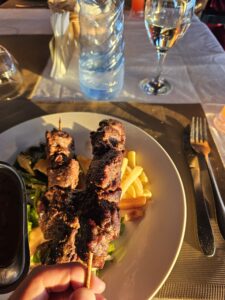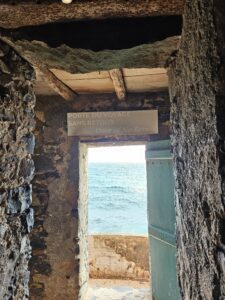Dakar (1): Africa
May 2, 2024
by Scott JIAXIN
As we touched down, the heat hit us, much like it did between Paris and Rabat, but Senegal amplified it. Heat and sunlight were the first things on my mind. But Senegal, known for its Teranga, greeted us with unexpected kindness from random drivers who helped us with our luggage.
The landscape was dry, reminiscent of what I saw in Morocco’s Merzouga desert. Under the relentless sun, vegetation somehow thrived amidst dusty plains. Yet, Dakar was a different scene, bustling with human activity, vibrant colours, and constant energy. I remember seeing my first Baobab tree while I was in the van; little did I know that the baobab fruit would become a staple drink that I would take in any Senegalese restaurant. The thick acidic consistency was really something that I thought fruits would never produce, but boy was I wrong.
In Dakar, one would see cars. A lot of them. There are the small yellow ones, often in a bad state but still functional, that blare their horns just to liven up the atmosphere. Then there are these white vans, often painted with lively illustrations and Quranic verses. I was shocked when I saw passengers hang on to the rails at the back of these buses, but hey, it’s Senegal. It’s a beautiful mess of sounds, colours, and dust, and it was an experience that really relativised things for me: gone were the amenities that I was accustomed to, and now an opportunity arises to take a dive in a culture essentially west-African and sub-saharan.
Perhaps Dakar’s most stunning view is its corniche. As we emerged from a tunnel, we were greeted by colourful canoes that piled upon each other. In French, we call them pirogues. Before the industrialisation of the fishing industry, these canoes were utilised by the Lebous, a Senegalese ethnicity, to fish. Each day, they would go out in 3s or 4s in these tight, narrow boats and would hopefully come back with a harvest worthy of a day’s work. The bustling of merchants and fishermen really was a stark contrast with the modern administrative buildings that were just on the other side of the boulevard. It was a beautiful display of modernity and tradition that I appreciated a lot.
For our welcome dinner, we ate at the La Playa restaurant, which had the most amazing diner (in my opinion). The skewers were of an immense size and the garnish was just so perfectly seasoned.

I wouldn’t know until later that grilled food is really a Senegalese specialty, and given my appetite for all things smoky and caramelised, it was a Godsend. There was this moment when one of our local guides Ahmad, anticipating the sunset to break his fast (he is Baha’i by the way, which is a really minority religion in Senegal), went out to the balcony to watch the sunset over the senegalese coast. I always found it really poetic; in ancient times, this is how believers broke their fast: they observed the rise and the fall of the sun, without any indication of time nor internet to tell you when it was appropriate to start eating.
One of the most memorable visits that we had was l’Ile de Gorée, a small island that served as a transit stop for the Atlantic slave trade. It was a sobering experience. Seeing the harsh conditions our ancestors endured was a stark reminder to appreciate our freedoms and our rights. The narrow, almost suffocating chambers where the slaves rested were physical footprints of what our forebears have suffered. The visit on its own was magnificent, but it was accompanied by a really moving explanation by a tour guide, which elaborated with detail the cruelty of this commerce and the peripeties of this small island, a longtime outpost for contact between the West and Africa.

As the tour guide said, we were on an island that is at the same time a UNESCO world heritage site. As citizens of the world, we are there to reflect on a painful past that has changed the course of human history. I found it really really touching to link this spiritual unity to a building that was meant to divide, categorise, and discriminate human beings.





